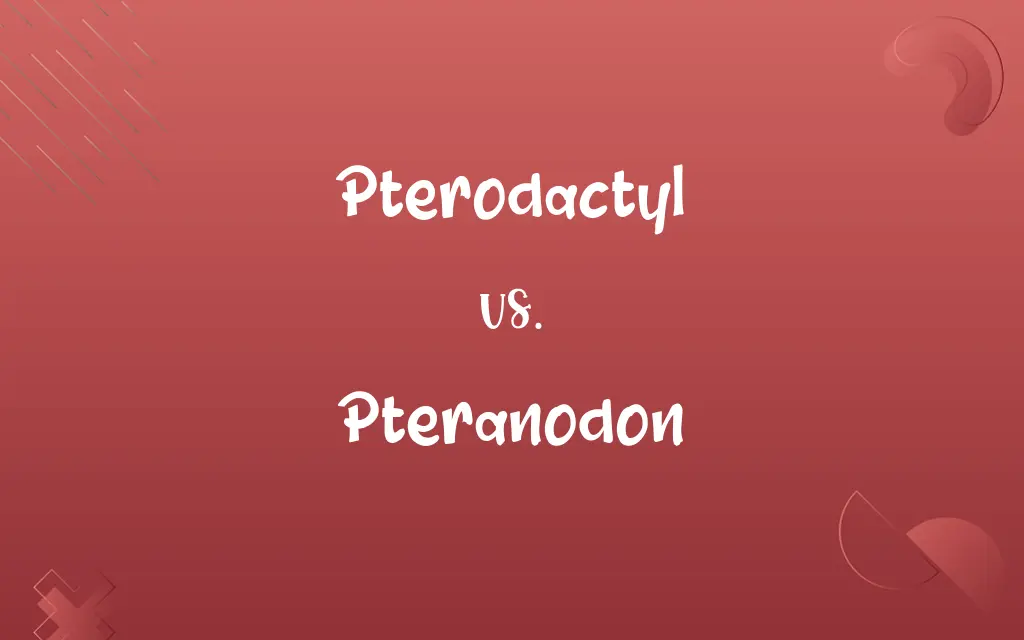Pterodactyl vs. Pteranodon: Know the Difference

By Shumaila Saeed || Published on January 20, 2024
Pterodactyls were small to medium-sized, toothed pterosaurs; Pteranodons were larger, toothless, and had longer wingspans.

Key Differences
Pterodactyl, a term often used colloquially to refer to members of the Pterosauria group, typically had smaller body sizes and possessed teeth. Pteranodon, a specific genus of pterosaur, was notable for its larger size, with a wingspan reaching over 20 feet, and it lacked teeth, which distinguished it from many other pterosaurs.
Shumaila Saeed
Jan 20, 2024
The Pterodactyls, particularly the Pterodactylus genus, were known for their long, curved wings and could be found in various sizes, from small to medium. In contrast, Pteranodons had remarkably long wingspans and a distinct crest on their heads, making them one of the most recognizable pterosaurs.
Shumaila Saeed
Jan 20, 2024
Pterodactyls lived during the late Jurassic period and were widespread, with their fossils found in Europe and Africa. Pteranodons, on the other hand, thrived during the late Cretaceous period and were predominantly found in North America, indicating a different geographical distribution and timeline.
Shumaila Saeed
Jan 20, 2024
In terms of diet, Pterodactyls, with their teeth, likely fed on fish, insects, and other small animals. Pteranodons, being toothless, are believed to have primarily been fish-eaters, catching their prey while flying over water bodies.
Shumaila Saeed
Jan 20, 2024
Regarding locomotion, Pterodactyls, while adept flyers, were also capable of moving on all fours on land. Pteranodons, with their larger size and wing structure, were primarily adapted for flight, with less emphasis on land mobility.
Shumaila Saeed
Jan 20, 2024
ADVERTISEMENT
Comparison Chart
Physical Features
Teeth, long curved wings
Toothless, long wings, distinct head crest
Shumaila Saeed
Jan 20, 2024
Geographical Spread
Found in Europe and Africa
Predominantly in North America
Shumaila Saeed
Jan 20, 2024
ADVERTISEMENT
Locomotion
Capable of flying and moving on all fours
Primarily adapted for flight
Shumaila Saeed
Jan 20, 2024
Pterodactyl and Pteranodon Definitions
Pterodactyl
A genus of small to medium-sized, toothed pterosaurs from the late Jurassic period.
The Pterodactyl fossil exhibited at the museum showed its distinct teeth and wing structure.
Shumaila Saeed
Jan 04, 2024
Pteranodon
A large, toothless pterosaur with a long wingspan, living in the late Cretaceous period.
The Pteranodon is often depicted in media soaring over ancient seas with its massive wings.
Shumaila Saeed
Jan 04, 2024
Pterodactyl
Had a widespread presence in the late Jurassic era across Europe and Africa.
Pterodactyl fossils are significant in understanding the diverse wildlife of the Jurassic period.
Shumaila Saeed
Jan 04, 2024
Pteranodon
Characterized by a distinct head crest and primarily fish-based diet.
The Pteranodon's crest could have been used for mating displays or aerodynamic purposes.
Shumaila Saeed
Jan 04, 2024
ADVERTISEMENT
Pterodactyl
A member of the broader Pterosauria group, often colloquially referred to as 'flying dinosaurs'.
Children are often fascinated by the Pterodactyl, imagining it soaring through ancient skies.
Shumaila Saeed
Jan 04, 2024
Pteranodon
One of the most recognizable pterosaurs due to its size and unique features.
The Pteranodon's silhouette is iconic among prehistoric creatures.
Shumaila Saeed
Jan 04, 2024
Pterodactyl
Known for its curved wings and varied diet including fish and insects.
Scientists believe the Pterodactyl was a versatile hunter, feeding on various small prey.
Shumaila Saeed
Jan 04, 2024
Pteranodon
Excelling in flight, it was less equipped for land movement compared to smaller pterosaurs.
The Pteranodon's skeletal structure highlights its adaptation for long-distance flight.
Shumaila Saeed
Jan 04, 2024
Pterodactyl
Exhibited the ability to fly and walk on all fours.
The Pterodactyl's unique skeletal structure allowed it to navigate both air and land.
Shumaila Saeed
Jan 04, 2024
Pteranodon
Mainly found in what is now North America, indicating a specific geographical habitat.
Pteranodon fossils in Kansas provide insights into the prehistoric ecosystems of North America.
Shumaila Saeed
Jan 04, 2024
Pterodactyl
Any of various pterosaurs of the group Pterodactyloidea of the Jurassic and Cretaceous Periods, having a short tail or no tail, and including the pteranodons.
Shumaila Saeed
Jan 04, 2024
Pteranodon
Any of several large pterosaurs of the genus Pteranodon of the Cretaceous Period, having a long crested head, a scooplike beak, no teeth, and a wingspan of over 8 meters (26 feet).
Shumaila Saeed
Jan 04, 2024
Pteranodon
A member of Pteranodon, a genus of large pterosaurs, the males of which had a bony crest on the back of the head.
Shumaila Saeed
Jan 04, 2024
Pteranodon
A genus of American Cretaceous pterodactyls destitute of teeth. Several species are known, some of which had an expanse of wings of twenty feet or more.
Shumaila Saeed
Jan 04, 2024
Pterodactyl
An extinct flying reptile; one of the Pterosauria. See Illustration in Appendix.
Shumaila Saeed
Jan 04, 2024
Repeatedly Asked Queries
Were Pteranodons found worldwide?
They were predominantly found in North America.
Shumaila Saeed
Jan 20, 2024
Did Pteranodons have a varied diet?
They primarily ate fish due to being toothless.
Shumaila Saeed
Jan 20, 2024
What is a common misconception about Pterodactyls?
That they are 'flying dinosaurs'; they are actually pterosaurs.
Shumaila Saeed
Jan 20, 2024
Were Pterodactyls as large as Pteranodons?
No, Pteranodons were generally larger.
Shumaila Saeed
Jan 20, 2024
What adaptations did Pterodactyls have for flight?
Long, curved wings and a lightweight body.
Shumaila Saeed
Jan 20, 2024
How did Pteranodons impact their ecosystem?
As top predators, they played a significant role in marine ecosystems.
Shumaila Saeed
Jan 20, 2024
Is the Pteranodon considered a dinosaur?
No, it's classified as a pterosaur.
Shumaila Saeed
Jan 20, 2024
How did the diet of Pterodactyls vary?
They ate fish, insects, and possibly other small animals.
Shumaila Saeed
Jan 20, 2024
Were Pteranodons solitary or social animals?
This is not definitively known, but some evidence suggests they might have been social.
Shumaila Saeed
Jan 20, 2024
How did Pteranodons capture their prey?
Likely by diving or skimming over water.
Shumaila Saeed
Jan 20, 2024
Are Pterodactyl and Pteranodon from the same family?
No, they belong to different genera within the Pterosauria group.
Shumaila Saeed
Jan 20, 2024
What distinguishes Pteranodon fossils from other pterosaurs?
Their large size, toothless beak, and distinctive head crest.
Shumaila Saeed
Jan 20, 2024
Share this page
Link for your blog / website
HTML
Link to share via messenger
About Author
Written by
Shumaila SaeedShumaila Saeed, an expert content creator with 6 years of experience, specializes in distilling complex topics into easily digestible comparisons, shining a light on the nuances that both inform and educate readers with clarity and accuracy.








































































